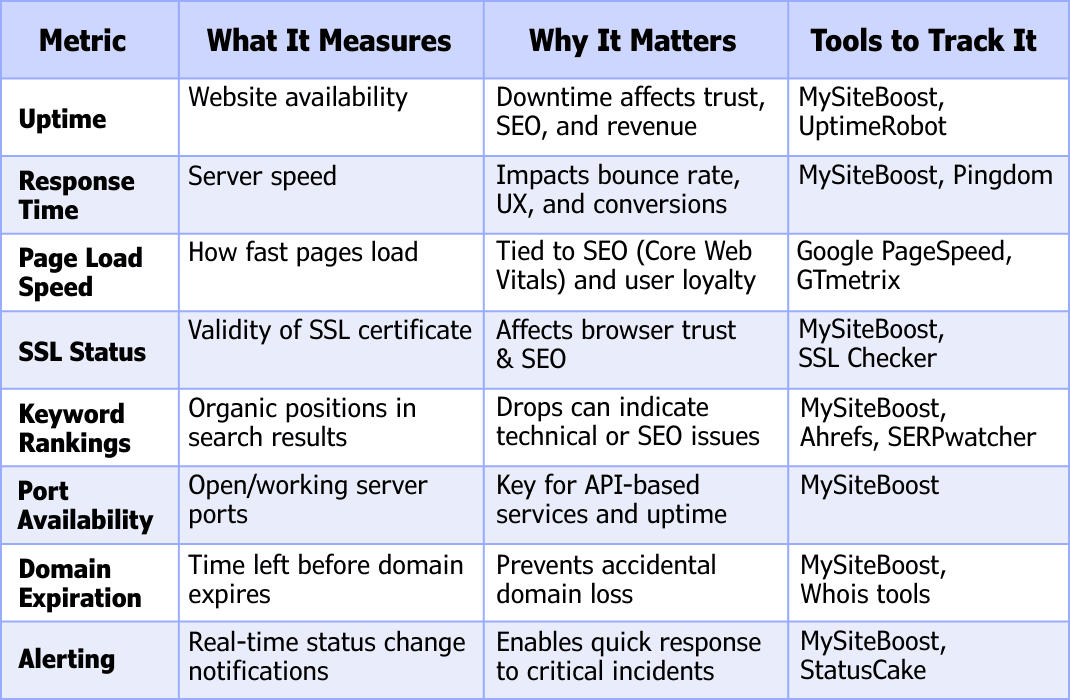What’s worse than launching a startup site with bugs? Not knowing those bugs even exist. Imagine pouring months into designing your dream product, building a sleek landing page, crafting messaging — only to realize your site went down for hours and no one noticed. Or worse, it loads so slowly that users bounce before they even see your offer. In today’s digital-first world, a reliable website isn’t a nice-to-have — it’s your startup’s lifeline. That’s why tracking the right website monitoring metrics from the very beginning is vital for performance, SEO, credibility, and long-term success.
Website Monitoring Metrics Every Startup Should Track from Day One
Nadiia Sidenko
2025-03-27

Website Monitoring Metrics Every Startup Should Track from Day One
Why Website Monitoring Is Critical for Startups
Launching a startup often means wearing many hats — marketing, development, support — and in the chaos, site performance can slip through the cracks. But one unnoticed outage or slow-loading page can result in missed revenue, lost users, and weakened SEO. Monitoring your website is how you keep those cracks sealed.
Website monitoring tools provide the visibility needed to detect issues before users or search engines do. Whether you're dealing with downtime, slow responses, expired SSL certificates, or broken ports, having a clear strategy in place ensures long-term site health and performance. Knowing what makes up a solid website monitoring strategy helps startups stay ahead of disruptions.
How Monitoring Helps Startups Avoid Downtime and Performance Issues
Startups often face resource constraints — both technical and financial — making them more vulnerable to unplanned outages. A single hour of downtime can cost hundreds or thousands of dollars, not to mention the damage to user trust.
Imagine this scenario: your site goes down at 7 PM on a Friday — peak time for weekend traffic — and no one on your team realizes it until Monday. That’s two full days of lost visibility, revenue, and potential customer confidence. Proactive monitoring allows businesses to detect disruptions early and act fast.
The Role of Website Monitoring in SEO, Security, and User Experience
Search engines reward fast, secure, and reliable websites. Slow load speeds and broken SSLs not only frustrate users but also result in lower rankings. Monitoring ensures your startup meets Google’s expectations and provides a frictionless user journey — both essential for growth.
The Most Important Website Monitoring Metrics for Startups
There are dozens of metrics you could track — but which ones truly matter in the early stages? Startups need to focus on the foundational indicators of uptime, speed, responsiveness, reliability, and keyword visibility. If you're not familiar with all the terms, this performance glossary offers a helpful breakdown.
To give you a clearer picture, here’s a breakdown of the most important website monitoring metrics startups should focus on — along with their purpose and tools you can use to track them effectively:

Uptime Monitoring: Ensuring Website Availability
What Uptime Monitoring Is and Why It Matters
Uptime monitoring tells you whether your website is accessible at any given moment. Even 99% uptime can result in more than 7 hours of downtime a month. That’s a big deal if those hours occur during peak traffic.
How Frequent Downtime Affects SEO and User Trust
When your website is frequently inaccessible, search engines can lower your rankings. Users encountering a down page may never return. According to insights on monitoring trends for 2025, reliability will continue to play an even greater role in both user retention and technical SEO.
Response Time: The Speed Factor in User Experience & SEO
How Response Time Impacts Bounce Rates and Conversions
Response time measures how long your server takes to respond to a request. A sluggish response — even by just a second — can cause users to abandon your site. According to Google, 53% of mobile users leave a site that takes more than 3 seconds to load
Benchmarks for Optimal Response Time for Startups
Aim for a server response time under 200 milliseconds. Anything higher, and you risk performance penalties from search engines and user dissatisfaction.
Load Speed & Page Performance Metrics
How Google’s Core Web Vitals Affect Search Rankings
Google’s Core Web Vitals — including Largest Contentful Paint (LCP), First Input Delay (FID), and Cumulative Layout Shift (CLS) — are now official ranking signals. These metrics assess how quickly and smoothly your pages load and respond to users.
The Role of Caching, CDN, and Image Optimization in Reducing Load Times
Using content delivery networks (CDNs), enabling caching, and compressing images can dramatically boost load speed. For startups, these are low-cost wins that improve UX and SEO in one shot.
Keyword Monitoring: Tracking Your Visibility
Keyword monitoring helps startups understand how their website ranks for target queries over time. If your performance drops suddenly, it could indicate technical issues like crawlability problems or downtime. Tools like MySiteBoost make it easier to track critical keywords and spot SEO issues early, before they affect your visibility or traffic.
Why Startups Need Performance Monitoring from Day One
Many startups postpone performance monitoring until it’s too late — after users complain or traffic dips. But by that point, the damage is done.
The Cost of Poor Website Performance for Startups
Performance issues can affect everything from bounce rates to brand credibility. They make it harder to scale and convert visitors into customers.
Picture this: a small eCommerce startup is featured in a popular online blog, driving a traffic spike — but their site wasn’t optimized or monitored. It crashes within minutes, and the window of opportunity slams shut. Moments like this can define a startup’s trajectory.
Why Early-Stage Businesses Need Real-Time Monitoring to Stay Competitive
With the right monitoring system in place, you don’t just react to problems — you prevent them. Startups using solutions like MySiteBoost can automate the detection of performance bottlenecks, track keywords, monitor SSL certificates, and get alerts before users are even aware something’s wrong.
Common Website Monitoring Mistakes Startups Make
Here are some of the most frequent — and avoidable — errors:
- Not setting up automated monitoring alerts
- Ignoring SSL certificate expiration
- Relying only on manual checks
- Underestimating the importance of response time
- Neglecting keyword visibility tracking
Not Setting Up Automated Monitoring Alerts
How Instant Notifications Can Prevent Critical Downtime
Manual checks won’t cut it. Real-time alerts notify you the moment something goes wrong — whether it's a server crash or an expired domain.
Best Tools for Setting Up Real-Time Alerts
Services like MySiteBoost allow you to set up customizable alerts via email, Slack, or webhook, so you’re always in the loop.
Ignoring SSL Expiration & Security Monitoring
Why SSL Monitoring Is Crucial for Maintaining Trust
An expired SSL certificate leads to browser warnings and lost credibility. Users may assume your site is unsafe.
The Impact of SSL Failures on SEO and Customer Retention
Search engines penalize non-secure websites. SSL monitoring helps ensure your certificate stays valid, which is key to user trust and SEO consistency.
Relying Only on Manual Website Checks
Why Automated Monitoring Is More Reliable Than Manual Audits
Even small websites can experience issues between manual audits. Automated tools check your site 24/7, catching problems as they arise.
How to Integrate AI-Powered Monitoring for Better Efficiency
Modern platforms like MySiteBoost are beginning to integrate predictive analytics and AI monitoring, helping identify issues before they cause downtime.
Future Trends in Website Monitoring for Startups
The Rise of AI-Driven Monitoring and Predictive Analytics
AI is transforming how we approach uptime and performance. Machine learning algorithms can analyze patterns and suggest fixes before an issue even occurs.
How Startups Can Prepare for Upcoming SEO and Performance Monitoring Trends
Future-ready startups are already investing in tools that scale with their growth. Real-time insights, predictive alerts, and keyword monitoring are becoming the norm — not the luxury.
Final Thoughts
For startups, every second counts — and every visitor matters. By investing in proper website monitoring early, you lay the foundation for a high-performing, SEO-friendly, and user-centric site. With comprehensive tools like MySiteBoost providing domain, port, SSL, uptime, and keyword monitoring, startups don’t have to fly blind. They can monitor, adapt, and grow — all in real time.
Website Monitoring Metrics Every Startup Should Track from Day One
Why Website Monitoring Is Critical for Startups
How Monitoring Helps Startups Avoid Downtime and Performance Issues
The Role of Website Monitoring in SEO, Security, and User Experience
The Most Important Website Monitoring Metrics for Startups
Why Startups Need Performance Monitoring from Day One
Common Website Monitoring Mistakes Startups Make
Future Trends in Website Monitoring for Startups
Final Thoughts